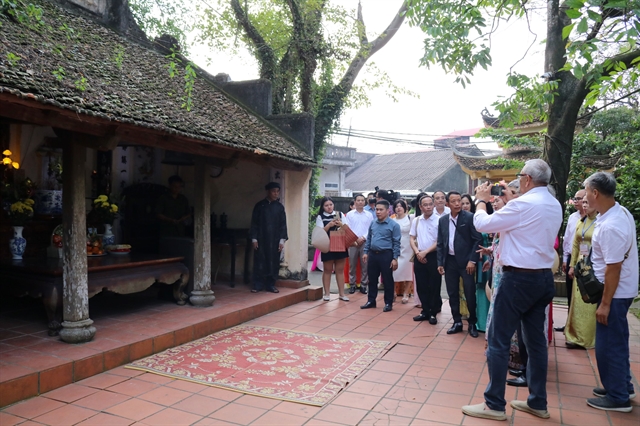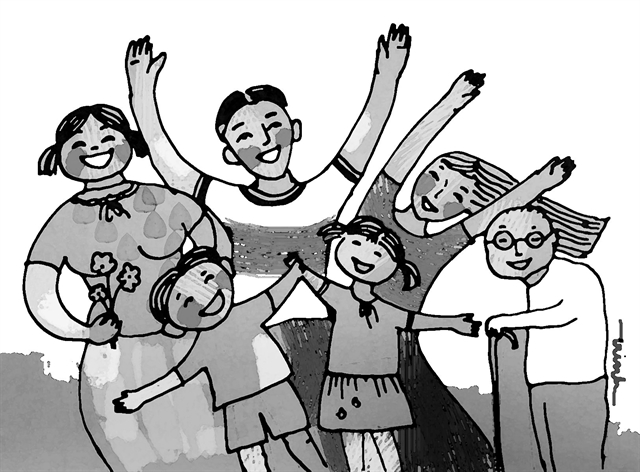 Society
Society


|
| Illustration by Kiều Trinh. |
Bích Hường
For the first time ever in Việt Nam, a happiness index has been included in a provincial plan for socio-economic development as a key indicator besides conventional metrics such as GDP, poverty rate, employment and social investment.
The northern province of Yên Bái has adopted the Happiness Index in the provincial Party Congress’s resolution to consider the satisfaction, joy and happiness of its citizens during the 2020-25 tenure.
According to head of the province’s Propaganda and Training Department Nguyễn Minh Tuấn, the index was calculated following a method developed by the New Economics Foundation (NEF) – a British think-tank that promotes “social, economic and environmental justice”.
A survey was conducted in the province collecting responses from over 2,000 local residents in three criteria – life satisfaction, life expectancy and contentment with living environment.
Life satisfaction is calculated using four factors: economic condition, family and social relationships, social welfare, and transactions with State agencies and authorities.
The living environment value is measured using the engagement of local authorities in developing urban/rural areas as well as protecting the environment, particularly the forests – a key feature of the mountainous province.
The survey also asked for the estimated average life expectancy of local residents, which gave them three options – 65, 70 and 75 years old. About 41.6 per cent of respondents chose 70, making it the most common choice.
Tuấn said the survey also showed that 40.71 per cent of respondents said they were satisfied with life in the province, and 31.8 per cent said they were satisfied with the living environment.
The final calculation on Yên Bái’s Happiness Index stood at 53.3 per cent, implying that local people were "relatively happy".
A percentage of less than 50 per cent would have meant “unhappy”, while a percentage of more than 70 per cent would imply "happy”.
“The province wants to increase the index by 15 per cent in the next five years to near the 'happy' level,” Tuấn said.
The province's People’s Committee chairman Đỗ Đức Duy said that if they assessed the province by just looking at economic growth and State budget collection, Yên Bái would still be classed as a disadvantaged locality in Việt Nam.
“We didn’t intend to change the way we assess the province’s performance when we decided to develop the Happiness Index,” Duy said, emphasising that the province wanted to affirm its own development motto for citizens’ satisfaction and happiness.
Duy said that when it came to happiness, everyone had their own definition.
Most people in Yên Bái live in remote mountainous areas and come from ethnic groups, so their main priority is safety and protection from natural diseases, rather than material things.
Life in the province revolves around the forest and that's how most people want to make a living, rather than leaving their hometown to work overseas or in other localities. With improvements to school infrastructure, children are more likely to attend school more regularly than in the past, and their parents are happy to see their children study, have meals and sleep safely.
“Happiness to them is simple and visible,” Duy said, adding that many people from ethnic groups living in remote areas had told him that roads connecting their villages was their biggest joy.
Happiness to many people can be an abstract concept, but to others it can be very specific and “countable”.
“Yên Bái authorities chose to use the Happiness Index to effectively concretise and implement its socio-economic tasks for the next five years to reach the final goal of bringing prosperity and happiness to the people,” Duy said.
UNDP Policy Officer Đỗ Thanh Huyền told the Radio of Vietnam (VOV) the presence of the Happiness Index in Yên Bái’s development resolution showed the willingness and initiative of local leaders to change and innovate.
“There are criteria and indicators being used to assess the socio-economic development of localities across Việt Nam as well as to measure citizens’ satisfaction with public services that more or less, directly or indirectly, affect their lives,” Huyền said.
People felt happy for different reasons. Some were happy when their children were healthy, while others were happy when they finished their work, Huyền said, adding that to a community or the whole of society, there were different influences upon happiness and life satisfaction.
“The quality of public services has to be one of the most important,” she said, citing the case of Buhtan – the so-called happiest nation in the world.
In Buhtan, good governance, citizens’ participation in policy-making, decision-making and their satisfaction with public services were taken into account to measure happiness, Huyền said, adding that pleasant or unpleasant experiences with public services lingered in people's memories.
With other existing indexes in Việt Nam, the Happiness Index would help reflex citizens’ satisfaction with public governance, public services and the Government’s efforts to ensure a better life for the people, Huyền said.
The index together with large scale public surveys has helped policymakers to listen and understand public concerns, but more importantly, State, Government bodies, leaders and State employees needed to respond to those concerns and make changes/adjustments.
In the case of Yên Bái Province, which is home to many ethic groups, it was very important and useful to listen to the public.
“People from the Kinh group feel happiness differently from those of the Tày or H’mong groups. So, if their voices and experiences are all listened to equally, we can expect more harmonised policies and behaviour,” Huyền said.
My first impression of Yên Bái’s Happiness Index was that it was too abstract because the conception of happiness is so general, differing from person to person.
How is happiness measured? Can the Happiness Index correctly reflect reality?
Thanks to Duy and Huyền’s explanations, now I could not agree with it more, at least as a member of the community and society.
Good governance and improved quality of public services are the keys to public happiness. When basic needs are met at an acceptable level, we think more positively.
You don't find many people who are happy with traffic jams, overcrowded hospitals, unsafe food, lack of jobs/income or insufficient facilities in schools.
Fixing these problems and giving it a name, I appreciate the new approach Yên Bái has adopted. Hopefully, other localities can find new and better ways to help people live happier lives. However, like many others, I want to see action taken now. VNS




